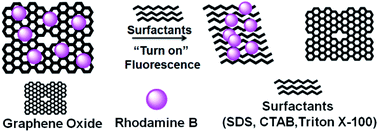A graphene oxide-based fluorescent sensor for surfactants†
Abstract
Many sensors have been reported for either anionic or cationic surfactants or non-ionic surfactants. Until now, only a few solitary sensor materials have been reported for both ionic and non-ionic surfactants. Such common fluorescent sensors for both ionic and non-ionic surfactants are very scarce. Here, we utilized rhodamine B (RhB)-anchored reduced graphene oxide (RBGO) for sensing all types of surfactants. RBGO responded to these surfactants down to the lowest concentration of 10−6 M. The concentrations of the surfactants were measured by the quantitative release of RhB from the graphene materials with respect to the quantity of the surfactants present in the solution. Furthermore, we also demonstrated a visual detection method for the ionic and non-ionic surfactants using the RBGO complex, which helped visualize the surfactants under a UV (365 nm) source conveniently, and this might help visualize the surfactants at any location easily. Therefore, this facile supramolecular assembly of RBGO can be a good complementary tool for the detection of surfactants from environmental samples.



 Please wait while we load your content...
Please wait while we load your content...